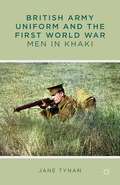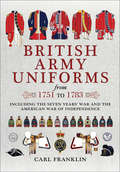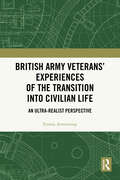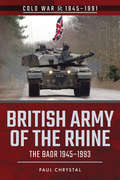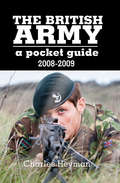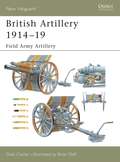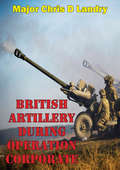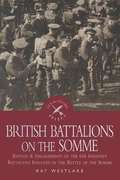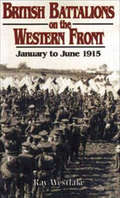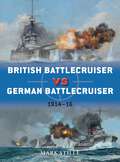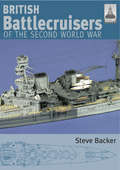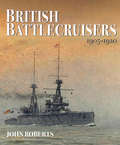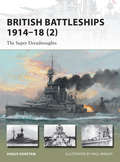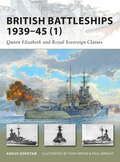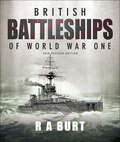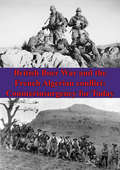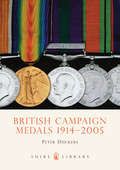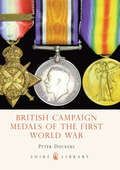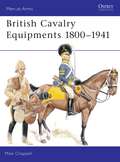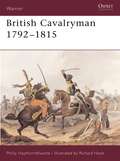- Table View
- List View
British Army Uniform and the First World War: Men in Khaki
by J. TynanJane Tynan offers new perspectives on the cultural history of the First World War by examining the clothing worn by British combatants on the western front. Khaki emerges as a significant part of war experience, which embodied gender, social class and ethnicity, impacted the tailoring trade and became a touchstone for pacifist resistance.
British Army Uniforms from 1751 to 1783: Including the Seven Years' War and the American War of Independence
by Carl Franklin&“Of great use to anyone interested in the 18th century British Army as well as illustrators and others who need detailed information.&”—Classic Arms and Militaria Based on records and paintings of the time, this book identifies each cavalry and infantry regiment and illustrates changes in uniforms, their facing colors, and the nature and shape of lace worn by officers, NCOs and private soldiers from 1751 to 1783. Regiments that served in the American War of Independence are noted and the book includes more than 200 full-color plates of uniforms and distinctions. Divided into four sections, it not only details the cavalry and infantry uniforms of the period but also the tartans of the Highland regiments, some of which were short-lived, and the distinction of the Guards regiments. &“A superb reference work, full of clearly researched details…it will be of value to family and military historians, re-enactors, figure painters, and wargamers.&”—FGS Forum
British Army Veterans’ Experiences of the Transition into Civilian Life: An Ultra-Realist Perspective
by Emma ArmstrongOver the last few decades, the academic and public gaze has increasingly focused on military veterans. The extant literature has documented a wealth of problems that emerge once a service leaver enters civilian life, including homelessness, mental health issues, criminality, and substance misuse. Accordingly, the intention to improve the wellbeing of veterans in the UK has certainly been evident within various government-initiated strategies.However, most scholarly attention has concentrated on the few veterans who encounter these extreme transitions. This book sheds light on the vast majority who are deemed to have an ‘unproblematic’ transition on account of their employment status and lack of serious social or health issues by drawing on data from 58 interviews with Army veterans, spouses of Army veterans, and charity workers. By mapping participants trajectory from pre-military life to years after service, a holistic theorisation of the transition is provided using the tenets of ultra-realism.It shows that, for most, merely being in employment was not an accurate measure of success. Instead, entrance to the civilian job market was characterised by precarity and intense competition between employees. This served as a dichotomy to the work environment veterans were familiar with and caused tension between the subject and the ideology they were assimilated to. In putting forward this argument, this book advances the existing ultra-realist theoretical framework and veteran research in an empirically informed manner.
British Army of the Rhine: The BAOR, 1945–1993 (Cold War, 1945–1991)
by Paul ChrystalThe nervous geopolitical tension between East and West, the Cold War, emerged before the end of the Second World War and lasted until 1991 with the collapse of the Soviet Union. The British Army of the Rhine was born in 1945 out of the British Liberation Army at the close of the war as the military government of the British zone of occupied Germany. As the Soviet threat increased, so BAOR became less of an occupational army and assumed the role of defender of Western Europe, and as a major contributor to NATO after 1949.This book traces and examines the changing role of BAOR from 1945 to its demise in the 1993 Options for Change defence cuts. It looks at the part it played in the defence of West Germany, its effectiveness as a Cold War deterrent, the garrisons and capabilities, logistics and infrastructure, its arms and armour, the nuclear option and the lives of the thousands of families living on the front line.
British Army, 2008–2009: A Pocket Guide (Military Reference Ser.)
by Charles HeymanThe British Army Pocket Guide 2008–2009 is a comprehensive guide to the organization, equipment and tactics of today's British Army. This latest edition incorporates details of all army reorganization and regimental amalgamations plus details of major systems and equipment introduced.
British Artillery 1914-19
by Brian Delf Dale ClarkeIn 1914 the artillery of Britain's 'Field Army' encompassed those weapons judged to have sufficient mobility to keep up with troops in the field. This book describes all major variants, from the 60-pdr guns of the heavy field batteries, perched somewhat uncomfortably on the cusp between field artillery and siege artillery, to the 2.75in. guns of the mountain batteries, almost toy-like in comparison. Between these two extremes lay the bulk of the artillery of the Field Army: the 13-pdr guns of the Royal Horse Artillery, and the 18-pdr guns and 4.5in. howitzers of the Royal Field Artillery batteries.
British Artillery During Operation Corporate
by Major Chris D Landry USMCBritish artillery played a major role in the land campaign to retake the Falklands from the Argentineans. The study of the Falklands Campaign provides an outstanding opportunity to analyze modern artillery in limited warfare.Faced with numerous challenges, both operationally and logistically, the professionalism and dedication of the British artillerymen proved extremely important to the success of the overall operation. Leaders employed the 105mm light guns in manners that utilized its strengths to deliver effects on the enemy and offer freedom of movement for friendly maneuver units. Specifically, during the assault towards Stanley, the British were able mass its artillery in a manner that overwhelmed the enemy. To accomplish this, the British overcame many operational and logistical challenges to ensure that artillery was positioned to support the fight and that it had on hand sufficient ammunition to complete the mission. More importantly, when called to fire, the artillery batteries were ready, willing, and able. Their fires proved critical in allowing the infantry units to close on the enemy...In the end, the final lesson, as spoken by the Commander of 3 Commando Brigade, Brigadier Thompson, was that artillery was the most important battle-winning factor.In the conduct of the campaign, British artillery usage provides three main lessons important to the U.S. Marine Corps Artillery community. First, it validated the need to have a lightweight gun in the inventory in order to support operations in areas of limited mobility. Second, the British practice of positioning the most senior artillerymen with the maneuver units proved to be an effective method of providing advice to the commander, conducting fire support planning, and making hasty adjusting to execution of plans. Finally, the campaign revealed the need to train artillerymen in realistic conditions in order to prepare them for the impact of combat operations.
British Battalions in France & Belgium, 1914: 1914
by Ray WestlakeA unique account of the 143 infantry battalions of the British Army that served in France and Belgium from August to the end of December, 1914, during WWI.Ray Westlake has painstakingly compiled a comprehensive compendium of the exact movements of every regiment involved on the various battlefields in France and Flanders during World War One. Detailed records of movements, both in and out of battle areas and on a day-by-day basis, are covered in the same meticulous style as the author’s previous books, British Battalions on the Somme and British Regiments at Gallipoli.
British Battalions on the Somme: Battles & Engagements of the 616 Infantry Battalions Involved in the Battle of the Somme
by Ray WestlakeAn account of the infantry battalions belonging to regiments of the British Army and the 63rd (Royal Naval Division) during their service in the Somme area.Although seventy-eight years have passed since the Battle of the Somme was fought, interest in this, the bloodiest battle of the First World War, has never waned. Ray Westlake has collated all the information so painstakingly gathered, to produce a comprehensive compendium of the exact movements of every battalion involved in the battle. This book is invaluable not only to researchers but to all those visiting the battlefield and anxious to trace the movements of their forebears.
British Battalions on the Western Front: January to June 1915
by Ray WestlakeThe author's previous three books in this series—British Battalions on the Somme, 1916, British Regiments at Gallipoli andBritish Battalions in France and Belgium, 1914 have achieved all that they set out to do. On the historical side it is now agreed by a large number of grateful historians, researchers, museum curators, librarians etc. that for the first time they are able to establish quickly and conveniently what part each unit played in these important campaigns. It was also intended to provide family historians with a means of tracing the war service of their relatives. This again has been accomplished. British Battalions in France and Belgium, January- June, 1915 sets out with the same objectives in mind, on this occasion providing a unique account of the 291 infantry battalions of the British Army that served in France and Belgium from 1st January to the end of June, 1915. Over 500 volumes of war diaries and unit histories have been consulted, along with personal memoirs and diaries. Detailed records of movements, both in and out of battle areas and on a day-by-day basis, being covered in the same meticulous style as before.
British Battle Planning in 1916 and the Battle of Fromelles: A Case Study of an Evolving Skill (Routledge Studies in First World War History)
by Roger LeeDespite the substantial output of revisionist scholarship over the last decade reappraising the performance of the British Army on the Western Front during the First World War, there still remains a stubborn perception that its commanders were incompetent, inflexible and unimaginative. Whilst much ink has been spilled vilifying or defending individual commanders, or looking for overarching trends and ’learning curves’, this is the first work to examine systematically the vertical nature of command - that is the transmission of plans from the high-command down through the rank structure to the front line. Through such an investigation, a much more rounded measure of the effectiveness of British commanders can be gained; one moves the argument beyond the overly simplistic ’casualties to ground gained’ equation that is usually offered. The Battle of Fromelles (19-20 July 1916) was selected as the case study as it was relatively small in scale, in the right period, and retains sufficient primary sources available to sustain the analysis. It also witnessed the first time Australian forces were used in offensive operations on the Western Front, and thus looms large in wider Commonwealth perceptions of ’Bumbling British Generals’. The book follows the progress of the battle plan from its inception in the strategic designs of the supreme commander down through the various intermediate level commands at operational and tactical headquarters until it became the orders that sent the infantry forward into the attack. In so doing it provides a unique insight into the strengths and weaknesses of British command structure, allowing a much more scholarly judgement of its overall effectiveness.
British Battlecruiser vs German Battlecruiser
by Paul Wright Mark StilleBattles at Dogger Bank and Jutland revealed critical firepower, armor, and speed differences in Royal Navy and Kaiserliche Marine (Imperial German Navy) Battlecruiser designs.Fast-moving and formidably armed, the battlecruisers of the British and German navies first encountered one another in 1915 at Dogger Bank and in the following year clashed near Jutland in the biggest battleship action of all time. In the decade before World War I Britain and Germany were locked in a naval arms race that saw the advent of first the revolutionary dreadnought, the powerful, fast-moving battleship that rendered earlier designs obsolete, and then an entirely new kind of vessel - the battlecruiser. The brainchild of the visionary British admiral John 'Jacky' Fisher, the battlecruiser was designed to operate at long range in 'flying squadrons', using its superior speed and powerful armament to hunt, outmanoeuvre and destroy any opponent. The penalty paid to reach higher speeds was a relative lack of armour, but Fisher believed that 'speed equals protection'. By 1914 the British had ten battlecruisers in service and they proved their worth when two battlecruisers, Invincible and Inflexible, sank the German armoured cruisers Scharnhorst and Gneisenau off the Falklands in December 1914.Based on a divergent design philosophy that emphasised protection over firepower, the Germans' battlecruisers numbered six by January 1915, when the rival battlecruisers first clashed at Dogger Bank in the North Sea. By this time the British battlecruisers had been given a new role - to locate the enemy fleet. Five British battlecruisers accompanied by other vessels intercepted and pursued a German force including three battlecruisers; although the battle was a British tactical victory with neither side losing any of its battlecruisers, the differences in the designs of the British and German ships were already apparent. The two sides responded very differently to this first clash; while the Germans improved their ammunition-handling procedures to lessen the risk of disabling explosions, the British drew the opposite lesson and stockpiled ammunition in an effort to improve their rate of fire, rendering their battlecruisers more vulnerable. The British also failed to improve the quality of their ammunition, which had often failed to penetrate the German ships' armour.These differences were highlighted more starkly during the battle of Jutland in May 1916. Of the nine British battlecruisers committed, three were destroyed, all by their German counterparts. Five German battlecruisers were present, and of these, only one was sunk and the remainder damaged. The limitations of some of the British battlecruisers' fire-control systems, range-finders and ammunition quality were made clear; the Germans not only found the range more quickly, but spread their fire more effectively, and the German battlecruisers' superior protection meant that despite being severely mauled, all but one were able to evade the British fleet at the close of the battle. British communication was poor, with British crews relying on ship-to-ship flag and lamp signals even though wireless communication was available. Even so, both sides claimed victory and the controversy continues to this day.
British Battlecruisers of the Second World War
by Steve BackerThe 'ShipCraft' series provides in-depth information about building and modifying model kits of famous warship types. Lavishly illustrated, each book takes the modeller through a brief history of the subject class, highlighting differences between sisterships and changes in their appearance over their careers. This includes paint schemes and camouflage, featuring colour profiles and highly-detailed line drawings and scale plans. The modelling section reviews the strengths and weaknesses of available kits, lists commercial accessory sets for super-detailing of the ships, and provides hints on modifying and improving the basic kit. This is followed by an extensive photographic survey of selected high-quality models in a variety of scales, and the book concludes with a section on research references—books, monographs, large-scale plans and relevant websites. The latest in this series covers the three ships of this First World War type, Hood, Repulse and Renown, which survived to fight in the Second. Still the fastest capital ships in the world in 1939, their protection was not up to contemporary standards and two were famously lost in action. Hood in an old-fashioned gunnery duel, but Repulse succumbed to the more modern threat of aerial attack. The one modernised ship, Renown, survived an adventurous wartime career.
British Battlecruisers, 1905–1920: 1905 - 1920
by John RobertsThe brainchild of Admiral Sir John Fisher, battlecruisers combined heavy guns and high speed in the largest hulls of their era. Conceived as super-cruisers to hunt down and destroy commerce raiders, their size and gun-power led to their inclusion in the battlefleet as a fast squadron of capital ships. This book traces in detail the development of Fishers original idea into first battlecruiser Invincible of 1908, through to the Splendid Cats of the Lion class, and culminating in HMS Hood in 1920, the largest warship in the world for the next twenty years. The origins of the unusual light battlecruisers of the Courageous type are also covered.
British Battles of the Spanish Civil War: How Volunteers from Britain Fought against Franco
by Charles J. EsdaileThe Spanish Civil War continues to attract attention as a brutal political and military struggle which foreshadowed the wider war across Europe that followed, and it has given rise to myths that have become commonplace since the war ended eighty years ago. Few of these myths are as potent as those associated with the International Brigades, the 45,000 volunteers from many countries who traveled to Spain to fight for the Second Republic. That is why this perceptive and original study by Charles Esdaile is so valuable. Using the recorded experience of the British Brigaders as well as primary research in the Spanish archives, he thoroughly re-examines the contribution they made to the war effort against the Nationalists of General Franco. During the war the Nationalists exaggerated the importance of the International Brigades in order to demonstrate the influence of the Communists on the Republic, and the Republicans portrayed them as part of the great crusade to defend democracy. Then, after the war, surviving Brigaders tended to overstate the part they played and the sacrifices they made. The one fact that nobody would dispute was the terrible losses sustained by the volunteers. This produced an impression that they were veritable men of iron who played a key part in the fighting and helped stave off the Nationalist victory until the eve of the Second World War. By concentrating in close detail on the major battles in which the British Brigaders took part, Charles Esdaile reassesses their impact and considers whether their performance on the battlefield justifies their reputation.
British Battleships 1914-18
by Paul Wright Angus KonstamThe launch of HMS Dreadnought in 1906 changed the face of naval warfare. This revolutionary new battleship was in a league of her own, capable of taking on any two "pre-dreadnought" battleships in a straight fight. A naval arms race followed between Britain and Germany, as both countries hurriedly built a fleet of these powerful new warships. This race led inexorably to the outbreak of a world war. During World War I these dreadnoughts formed the backbone of the British Grand Fleet. In May 1916, these battleships put to sea to intercept their counterparts in the German High Seas fleet. The result was the battle of Jutland, a bruising high-stakes encounter where the design and construction of Britain's revolutionary new battleships was put to the test. The first half-dozen dreadnoughts were all improvements of the basic Dreadnought design, all carrying ten 12-inch guns. It was only in 1911, with the launch of HMS Neptune that the layout of this powerful armament was altered as a result of practical experience. Two more versions of the Neptune entered service later that same year. These nine improved dreadnoughts formed the core of the British High Seas Fleet. They would soon, however, be outclassed by a new breed of "super dreadnoughts", the subject of the second volume in this two-part story. While these new battleships carried larger 13.5-inch guns, they proved less successful as all-round battleships than their more lightly-armed predecessors. Naval architects were slowly learning that with modern battleships, design involved a compromise between firepower, protection and speed. One last 12-inch gun dreadnought entered service in 1914, when a seven turret battleship being built for the Turks was commandeered by the Royal Navy, and re-named HMS Agincourt. This New Vanguard title, the first of two covering these famous warships will uncover the full story of the British battleships of World War I. The book will look at their revolutionary design, the 12-inch guns that provided them with their firepower, and the way these guns were fired in anger.
British Battleships 1919-1945: WWII Evolution of the Big Guns
by R.A. BurtThe classic reference on the Royal Navy&’s battleships and battlecruisers, now expanded with dozens of additional photos. Offering an unprecedented range of descriptive and illustrative detail, this naval history reference describes the evolution of the British battleship classes through all their modifications and refits. As well as dealing with design features, armor, machinery and power plants and weaponry, the author examines the performance of the ships in battle and analyzes their successes and failures. In addition to covering all the Royal Navy&’s battleships and battlecruisers, he also looks in detail at the aircraft carrier conversions of the WWI battlecruisers Furious, Glorious and Courageous. British Battleships 1919-1945 is a masterpiece of research, and the comprehensive text is accompanied by tabular detail and the finest collection of photographs and line drawings ever offered in such a book. For this new edition, the author has added some 75 new photographs, many of them never before published. A delight for the historian, enthusiast, and ship modeler, it is a volume that is already regarded as an essential reference work for this most significant era in naval history and ship design.
British Battleships 1939-45
by Tony Bryan Paul Wright Angus KonstamWith the outbreak of World War II, Britain's Royal Navy and her fleet of battleships would be at the forefront of her defence. Yet from a fleet of 12 battleships, ten were already over 20 years old, venerable veterans of World War I. Extensive modifications throughout the 1930s allowed these ships to perform a vital service throughout the six long years of conflict, and further improvements made during the course of the war enabled them to hold their own against their German and Italian counterparts. This title offers a comprehensive review of the development of these British battleships from their initial commissioning to their peacetime modifications and wartime service. Detailed descriptions of the main armament of each ship will offer further analysis of individual battleships' effectiveness, discussing how the guns were manned when engaging the enemy. Describing HMS Warspite during the battle of Matapan in 1941, the author details how this British battleship, together with other Royal Navy and Australian vessels, defeated the might of the Italian navy so that they never again threatened Allied fleets within the Mediterranean. With specially commissioned artwork and a dramatic retelling of key battleship engagements, this book will highlight what it was like on board for the sailors who risked their lives on the high seas.
British Battleships of World War One: New Revised Edition
by R.A. BurtThe classic reference on the technical history of British capital ship design and construction during the dreadnought era. A century ago at Jutland, Dogger Bank, Heligoland Bight, and the first battle for the Falklands, mighty squadrons of these great armored ships fought their German counterparts for command of the seas. Beginning with Dreadnought, this book continues to the end of the First World War, and all of the fifty dreadnoughts, &“super-dreadnoughts,&” and battlecruisers that served the Royal Navy during this era are described and superbly illustrated with photographs and line drawings. Each class of ship is described in detail so that design origins, and technical and operational factors, are discussed alongside characteristics, with special emphasis on armament, armor, and machinery. Fully detailed data tables are included for every class, and more than 500 photographs and line drawings illustrate the text. A delight for the historian, enthusiast and ship modeler, this volume is regarded as an essential reference work for this most significant era in naval history and ship design.
British Battleships, 1889–1904: New Revised Edition
by R.A. BurtA comprehensive look at Royal Navy warships in the pre-dreadnought era, with extensive photos and illustrations. The Russian war scare of 1884 and the public&’s anxiety about the Royal Navy&’s ability to fight a modern war at sea resulted in the Naval Defense Act of 1889 and a vast program of warship construction. Over the next twenty years a fleet of 52 battleships was built, construction finally interrupted by the revolutionary Dreadnought design. In this volume, the author presents full details of design and construction, armament, protection, machinery and performance, all backed up with accurate data tables listing design figures, trials results, and full particulars at different stages in the ships&’ careers. The history of each battleship is chronicled and the reader is reminded of their major contribution in the First World War. They bore the brunt of the action at the Dardenelles, bombarded the Belgium coast, patrolled the North Sea and the Channel, reinforced the Italian Fleet, and served in East Africa, the East Indies, and the White Sea. Most were extensively modified during the war and this variety has made them of special interest to the historian, enthusiast, and ship modeler. With the addition of many new photographs from the author's massive collection, this new edition is a must-have addition to every naval library.
British Boer War And The French Algerian Conflict: Counterinsurgency For Today
by Major Michael J. LackmanMilitary historical case studies provide insight for military planners. Military planners cannot afford to ignore history when planning in today's complex environment. This thesis analyzes military doctrinal changes and adaptation during Britain's Boer War and the French counterinsurgency war in Algeria. The Boer War serves as an example of doctrinal change during a counterinsurgency campaign. The French experience demonstrates the difficult task of fighting against an ambiguous enemy who uses terrorism as its primary tactic. A counterinsurgency comparison and analysis focuses on three issues present in both case studies: population control measures, operational tactics, and the civil military operations. The conclusion offers solutions to the military situation today based on the British and French counterinsurgency. This thesis argues history provides US military planners with the background to develop a successful counterinsurgency strategy for today's environment.
British Campaign Medals 1914-2005
by Peter DuckersSurveys the medals awarded to British personnel for military services from the First World War to operations of British forces in the opening years of the twenty-first century. The campaign medals awarded for the military actions have become a popular field for collectors, since the majority of British awards were officially named.
British Campaign Medals of the First World War
by Peter DuckersBritain has issued medals rewarding war service since at least the early nineteenth century, and increasingly through the period of its imperial expansion prior to 1914, but examples of many of the early types are now scarce. However, few families escaped some involvement with "the Great War" of 1914-18, and many still treasure the medals awarded to their ancestors for wartime service. Today, with a growing interest in British military history and particularly in family history and genealogy, more and more people want to trace their ancestors' past. This book looks in detail at the origin, types and varieties of the British medals awarded for general war service between 1914 and '18, and gives advice on researching the awards and their recipients.From the Trade Paperback edition.
British Cavalry Equipments 1800-1941
by Mike ChappellThis revised edition of Mike Chappell's original Men-at-Arms 138 represents nearly 20 years' new research. It covers the saddlery, horse furniture, and personal equipment of the British horsed cavalryman from the early stages of the Napoleonic Wars until the final disappearance of the mounted arm during World War II. Such details are essential for an understanding of how cavalry fought in the 19th and early 20th centuries, since the design of equipment was intimately connected with cavalry tactics in any particular period. Students of campaign history, and particularly modellers, will find here a mass of specific information, illustrated with photographs, diagrams, drawings and full colour plates.
British Cavalryman 1792-1815
by Richard Hook Philip HaythornthwaiteIn the campaigns of the French Revolutionary (1792-1802) and Napoleonic Wars (1799-1815), the deserved reputation of the British infantry has tended to overshadow the contribution of the cavalry, but in fact they did form an integral part of the army, carrying out duties crucial to the success of other arms. British Cavalryman 1792-1815 recounts what these duties were and examines the men who performed them. The different regiments of the cavalry are listed and some of the arm's more exotic or professional corps, such as the King's German Legion, examined.
